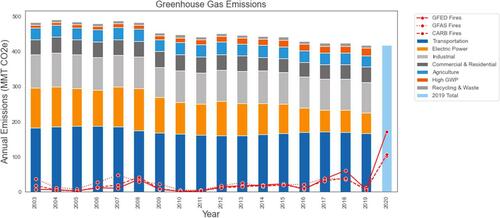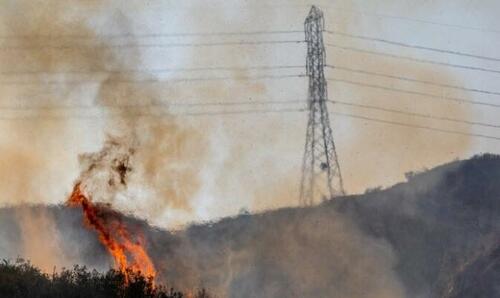California Wildfires Cancel-Out Two Decades Of Emissions Reductions
California Wildfires Cancel-Out Two Decades Of Emissions Reductions
In 2020, greenhouse gas emission reductions by California were negated by the CO2 from wildfires.
That’s according to a new study by researchers from UCLA and the University of Chicago, “Up in smoke: California’s greenhouse gas reductions could be wiped out by 2020 wildfires.”
“Wildfire emissions in 2020 essentially negate 18 years of reductions in GHG emissions from other sectors,” the study’s authors concluded.
Yet, comprehensive sensible policies could mitigate the wildfires. These policies include, especially, undergrounding power lines, which often spark onto dry wood, starting conflagrations.
According to the study, “We estimate that California’s wildfire carbon dioxide equivalent (CO2e) emissions from 2020 are approximately two times higher than California’s total greenhouse gas (GHG) emission reductions since 2003. Without considering future vegetation regrowth, CO2e emissions from the 2020 wildfires could be the second most important source in the state above either industry or electrical power generation.”
Their solution: “Our analysis suggests that significant societal benefits could accrue from larger investments in improved forest management and stricter controls on new development in fire-prone areas at the wildland-urban interface.” Those things would help.
But the state has lagged in dealing with its aging electricity infrastructure—a problem made worse, ironically, as more electric vehicles hit the road and need more juice from already overloaded power lines.
When I was state Sen. John Moorlach’s press secretary, 2017-20, one of his priorities was the power lines. In 2016, the year before I joined him, he sponsored Senate Bill 1463. It would have required the California Public Utilities Commission and CalFire to prioritize fire-hazard areas “associated with overhead utility facilities when determining areas which it will require enhanced mitigation measures for wildfire hazards.”
After scrupulous vetting by several committees, it passed unanimously in both houses of the Legislature. Then Gov. Jerry Brown vetoed it. Which made no sense.
In 2018, during another wildfire conflagration, the Daily Caller reported, “As California Burns, Jerry Brown Takes Heat for Vetoing 2016 Wildfire Mitigation Bill.” It quoted Moorlach, “Not addressing wildfires has reversed all the work we’ve done to reduce greenhouse gases. It’s inconsistent.”
Also in 2018, Moorlach introduced a new bill, numbered again Senate Bill 1463. It would have spent $600 million to mitigate wildfires. This time, things turned out better, as another bill, Senate Bill 901, grabbed the idea and included $200 million from cap-and-trade revenues to go toward wildfire mitigation. That bill was authored by state Sen. Bill Dodd (D-Napa), and the money at least was a start.
Flummoxed voters bounced Moorlach in 2020. That was just before the massive, unexpected surpluses of the past two years flowed into the state treasury. What an opportunity to sharply reduce greenhouse gases, not by some utopian edict of banning non-electric cars by 2035, but by actually doing something comprehensive about the spark-prone power lines.
There has been some action. Gov. Gavin Newsom’s summary of the budget enacted in June for fiscal year 2022-23 tallied, “The Budget includes $1.2 billion in additional actions to continue building forest and wildfire resilience statewide.”
Industry also is acting. According to San Diego Gas & Electric, its “Wildfire Mitigation Plan outlines a suite of programs and initiatives that the company will undertake to continue to advance wildfire safety. One of those initiatives is strategic undergrounding of overhead power lines.
“Burying power lines removes the risk of these lines sparking fires during adverse weather events, but more importantly, buried lines can remain energized during Public Safety Power Shutoffs, reducing the impact of power outages to fire prone communities.”
All that also is a start. But given the great emphasis put on reducing CO2 emissions by California politicians, and the immense cost imposed on residents here, shouldn’t this have been the top priority on spending this year’s $100 budget surplus?
According to one estimate, “At a cost of $3 million per mile, undergrounding 81,000 miles of distribution lines would cost $243 billion.” A lot of money. But, say, $50 billion could have been taken from the $100 billion surplus to underground the most vulnerable power lines.
Finally, Proposition 30 on this November’s ballot mainly is about increasing taxes on what supporters actually brand “Greedy Billionaires and CEOs.” Taxes would rise up to $4.5 billion a year to install electric vehicle chargers to benefit Lyft, the initiative’s sponsor. But as bait for voters, it also would spend 20 percent of revenues on a Wildfire Green House Gas Emissions Reduction fund. That could mean up to $900 million a year to reduce wildfires.
As with most issues—homelessness, crime, drought, tax reform, agriculture, energy—the state is taking a haphazard, piecemeal approach to fighting wildfires. The comprehensive approach the state took during its Golden Age of the 1940s-early 1970s—building the state water and schools systems, especially—is something no longer possible. Even as the state enters another season of wildfires, burning down homes and turning Californians into human S’mores.


Comments
Post a Comment